|
|
| |
 |
Diving Sites - Marsa
Alam |
|
| |
|
| |
|
This small,
isolated reef lies in the open sea, almost halfway
to Saudi Arabia.
Less than 800m (0.5 miles)
across, it is marked by a lighthouse which forms
the only break on the horizon for many miles in
any direction.
The reef has steep drops on the
east, north and south sides, all offering good
diving.
The southern side offers excellent shelter
form the prevailing north winds, and is the
preferred mooring point for visiting boats.
The profile of the reef on the three best sides is
very sheer, running form the surface to depths of
70m (230ft) or more. |
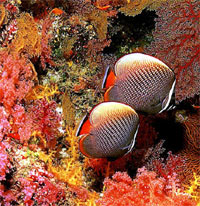 |
|
On the west side, there is a
drop-off with an ‘anemone city’, where you will
find astonishing concentrations of beautiful
anemones and a section of massive blue coral
growth.
To the north, the open water currents bring the best
selection of pelagic fish with frequent sightings of
the awesome manta rays especially in march to April.
Moving down the east coast, another impressive
drop-off runs toward the southeast tip of the reef,
where there have been repeated sightings of thresher
sharks.
This is a rare opportunity to see these
amazing predators up close.
They are easily
recognized by their elongated tails, with which they
are said to ‘thresh’ schools of smaller fish,
stunning them before eating them.
The reef is richly developed throughout, with good
coral growth from the surface to the depths.
Hard
and soft coral species are both well represented.
Fish life is as dense as you would expect on an
isolated reef pinnacle, with the usual reef species
complemented by large concentrations of schooling
species, such as snapper, long nose unicorn fish and a
variety of surgeonfish.
|
|
ELEPHANTINE REEF
This long, finger-like reef runs from north to south
in the open Red Sea.
Steep walls drop to the depths
on the reef’s east and west sides, reaching 70m
(230ft) or more, while the north and south ends of
the reef are marked by submerged plateau.
The
northern plateau is very shallow, offering some
superb snorkeling possibilities.
The southern
plateau is much deeper, with a drop-off at 30m
(100ft) leading down to the depths.
A large
underwater arch can be found here, between 50 and
70m (164-230ft).
This lies beyond the range of most
sports divers, but has a fascinating story attached
to it.
Legend has it that the sarcophagus of an
unknown pharaoh lies beneath the arch, and you can,
in fact, see the outlines of a suspiciously
rectangular, coral encrusted mass in the depths at
around 60m (197ft). |
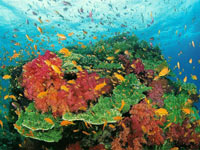
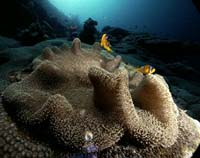
|
Coral coverage is dense and magnificent, with a full
range of hard and soft corals on all sides.
The east
side in particular has some beautiful soft coral
growth.
A massive number of reef species lends still more
color to the already dazzling walls, with a ready
supply of big solitary and schooling pelagic to
observe.
One great hammerhead seems to be a
permanent resident along with a very curious oceanic
white tip, a close encounter with this fish will
leave you buzzing for days.
This is an endlessly fascinating site, worth diving
any number of times, both by snorkellers and by the
more advanced diver.
|
SATAYA / DOLPHIN REEF
|
This horseshoe-shaped reef lies in open water to
the northeast of Ras Banas.
The eastern side of the reef has a steeply
sloping wall profile, giving way to a sandy
slope scattered with coral heads and pinnacles
toward the reef’s southeast corner. The lower
reaches of the reef are rather poorly covered,
with the best coral growth occurring in the top
10m (33ft).
The southern pinnacles are especially rich, with
a wide variety of coral types throughout.
The varied hard coral composition of the heads
and pinnacles acts as a base for some extremely
nice soft coral growth, particularly
dendronephthia.
Fish life here is excellent. |
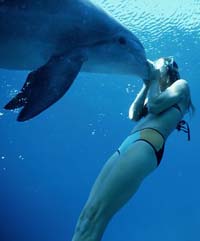 |
Schooling fish of all types are seen in large
numbers, while reef-dwellers, such as angelfish
and butterflies, provide flashes of color.
Cuttlefish and shrimps put in an appearance for
the invertebrates, and blue spotted and
black spotted stingrays are common.
Sharks of several types can also frequently be
spotted here, and there are regular reports of
dolphins along the reef or inside the lagoon as
they return here to sleep every night.
The good shelter provided by the reef makes this
an excellent stop for live-aboard. |
|
|
|
SHAAB SHARM |
|
This large, kidney-shaped reef, said to be the
top of a volcanic pinnacle, features a steep
sloping wall on its east and south sides, with a
considerable varied profile, especially on the
southeastern and southern stretches.
The crescent of reef around the reef’s southern
tip offers the best diving, with rich coral
growth from the surface shallows down, and the
most int4eresting profile and layout in the
area.
There are numerous undercut sections and reef
shelves harboring dense soft coral growth and a
good range of hard corals.
There are also some good black coral bushes on
the wall’s deeper sections.
Fish life is excellent, with a vast array of
huge grouper, schooling barracuda, massive
congregations of snapper and unicorns and some
|
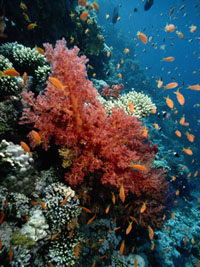 |
very large giant, yellow margin and yellow mouth
morays.
Currents here can be forceful, and less
experienced divers should pay close attention to
conditions.
|
|
DIVING the BROTHERS
The Brothers, or El Akhawein, are two small
islands in the middle (width-ways) of the Red
Sea.
Big Brother and Little Brother are a 10 minute
boat ride apart.
The larger Brother is home to a lighthouse
manned by the military.
Often surrounded by wild currents, the scenery
makes for some wonderful dives.
Add to this the high likelihood of seeing
sharks, and you're guaranteed fantastic
experiences.
We prefer the Little Brother for sheer
decorativeness, but it's a narrow decision.
The Brothers are steep-sided cones.
|
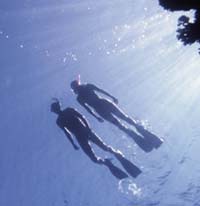 |
They were probably formed by volcanic action
caused by the spreading of the Red Sea rift.
The Egyptian authorities have acted to protect
the Brothers: the islands are periodically
closed to divers, and even when open a $5 (US)
fee per diver per day is charged (the money
going towards protecting the marine
environment).
At the moment diving is allowed so go whilst
you've got the opportunity.
A superb place to see sharks ,especially on
little Brother, often spotted here are
white tips, grey
reefs, hammerheads, silkys, threshers and another
very ( sometimes too )curious oceanic white tip!
There's also a possibility of seeing the rare
sunfish (mola mola). |
When to Go?
you need good weather to dive the Brothers.
It's an exposed spot with no shelter for boats
to moor up in.
Anchoring is forbidden so mooring is at
permanently fixed buoys.
In very bad weather these may be swept away.
The winds are often weakest during full moon,
and if you can stand the heat, the months of
June, July and August are the calmest.
Sharks increase in number from May.
ST JOHNS REEF / DEEP SOUTH
Just ten miles from the Sudanese border, the
massive reef system of St Johns was our next
destination.
St Johns spans 13 miles across and 8 miles in
length, and due to its remoteness it's one of
the last Red Sea wildernesses.
The reefs rise up from an enormous undersea
plateau.
Some are tiny and have yet to reach right up to
the surface.
Known as Habilis, these virgin reefs offer
virtually no protection to dive boats, but they
make breathtaking dives.
We dived on one simply known as Four Meter reef.
We could just see it below the surface and it
looked like we could have swam right round it in
five minutes, but once under the surface we
found it grew much wider.
Its walls plunged away sharply on all sides and
as we descended into the inky blue water, we
were mobbed by one of the biggest shoals of fish
I've ever encountered.
A mixture of fusiliers, surgeon and unicorn
fish, they danced all around us in mesmerizing
fashion and when they dispersed, behind them
were three or four white tip sharks.
Sharks are commonly encountered at St Johns.
Hammerheads, threshers and even oceanic white
tips are sometimes seen, whilst greys and white
tips are regularly sighted.
We were just happy to see the white tips, since
the warmer-than-normal water kept most of the
sharks in deeper water.
During the rest of the dive we cruised round the
undersea island, past millions of orange anthias,
yellow and black banner fish, groupers and
regal angelfish, and through bushes of
black coral and beautiful purple |
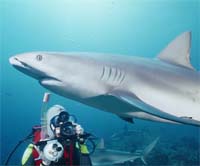 |
and orange soft corals.
At Sha'ab Martin, named after the Ghazala
Voyager skipper Martin De Banks (one of the last
European skippers operating in the Red Sea) we
were on the hunt for more sharks, but the only
ones a couple of our group encountered were in
60 plus meters! I wasn't too concerned as I
found myself swimming through huge shoal of
fusiliers, banner fish, butterfly fish and
snappers, past another forest of black coral and
some stunning sea fans. |
We also came across a turtle that was gorging
itself on coral like there was no tomorrow, and
watched Napoleon wrasse cruise round the reef
top, with a backdrop of hundreds of smaller
tropical fish and brilliantly colored coral
groupers.
Many of St Johns sites have yet to be given
proper names and are relatively unknown, but
there are a few exceptions.
Sha'ab Mharus is a fairly large reef, with sheer
walls adorned with beautiful sea whips and soft
corals, and riddled with caves.
Sha'ab Farag, a large circular reef, is also
very scenic with a huge overhang which dominates
a plateau on its south end, while along its east
wall a couple of caves are joined together by a
short tunnel and make entertaining exploration.
Close by there is a huge field of anemones and
resident clown fish.
Fish life at St Johns is refreshing; we saw
plenty of large shoals, with Napoleons and jacks
on just about every dive.
On a couple of reefs bump head parrotfish, a
species normally found further south in Sudan
can even be encountered.
|
|
|
|
|
|
|
|
|
|